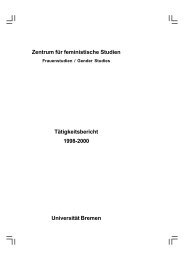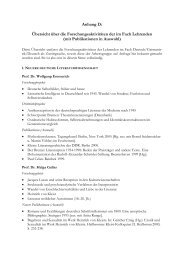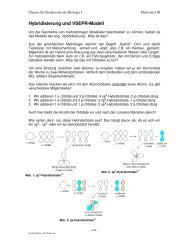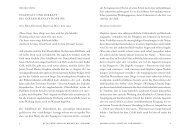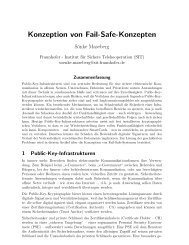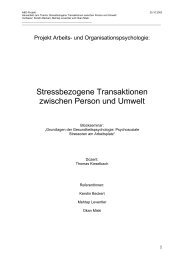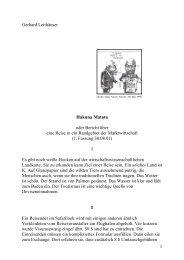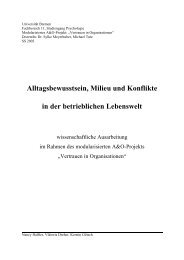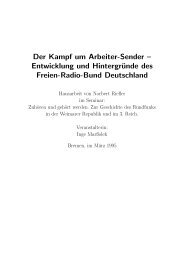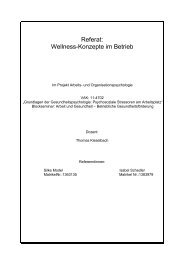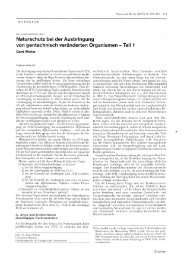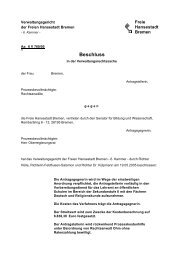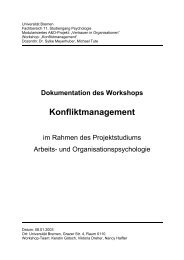- Page 1 and 2: A Textual Commentary on the Greek G
- Page 3 and 4: Lacunae of Q: 1:1-8 Lacunae of 1424
- Page 5 and 6: Codex Schoyen: We note in the follo
- Page 7 and 8: TVU 2 Minority reading: NA 27 Matth
- Page 9 and 10: omitted by Mt. So, many scribes add
- Page 11 and 12: TVU 4 Minority reading: NA 27 Matth
- Page 13 and 14: Compare also the discussion by Bruc
- Page 15 and 16: It might be interesting to identify
- Page 17 and 18: Compare also: NA 27 Matthew 2:1 Tou
- Page 19 and 20: TVU 6 Minority reading: NA 27 Matth
- Page 21 and 22: TVU 8 Minority reading: NA 27 Matth
- Page 23 and 24: NA 27 Matthew 18:30 o` de. ouvk h;q
- Page 25 and 26: original and corrected into 'a son'
- Page 27 and 28: TVU 12 Minority reading: NA 27 Matt
- Page 29 and 30: TVU 13 NA 27 Matthew 2:18 fwnh. evn
- Page 31 and 32: TVU 15 Minority reading: NA 27 Matt
- Page 33 and 34: TVU 17 2. NA 27 Difficult variant:
- Page 35 and 36: TVU 18 3. Difficult variant Minorit
- Page 37 and 38: TVU 20 4. NA 27 Difficult variant:
- Page 39 and 40: Note also the following addition: N
- Page 41 and 42: TVU 22 5. Difficult variant Minorit
- Page 43 and 44: The Latins reads "dixit ei" here. T
- Page 45: inscribitur Pauli Praedicatio", ke,
- Page 49 and 50: TVU 26 Minority reading: NA 27 Matt
- Page 51 and 52: TVU 27 NA 27 Matthew 4:10 to,te le,
- Page 53 and 54: TVU 28 8. Difficult variant: Minori
- Page 55 and 56: TVU 29 Minority reading: NA 27 Matt
- Page 57 and 58: TVU 30 9. NA 27 Difficult variant:
- Page 59 and 60: TVU 31 10. Difficult variant: Minor
- Page 61 and 62: Streeter "Four Gospels" (p. 250 foo
- Page 63 and 64: TVU 34 Minority reading: NA 27 Matt
- Page 65 and 66: TVU 35 Minority "Caesarean" reading
- Page 67 and 68: sugcwroume,nhj mhde. qumou/ tinoj e
- Page 69 and 70: TVU 37 Minority "Caesarean" reading
- Page 71 and 72: TVU 39 Minority reading: NA 27 Matt
- Page 73 and 74: So, the evidence here is not conclu
- Page 75 and 76: Rating: 2? (NA probably original)
- Page 77 and 78: Origen (2 nd CE, Fr. Matt. 104, s.
- Page 79 and 80: Parallel: NA 27 Luke 6:29 tw/| tu,p
- Page 81 and 82: Rating: - (indecisive)
- Page 83 and 84: TVU 46 NA 27 Matthew 5:47 kai. eva.
- Page 85 and 86: TVU 47 NA 27 Matthew 6:1 Prose,cete
- Page 87 and 88: TVU 48 NA 27 Matthew 6:4 o[pwj h=|
- Page 89 and 90: TVU 49 NA 27 Matthew 6:5 Kai. o[tan
- Page 91 and 92: TVU 51 NA 27 Matthew 6:6 o` ble,pwn
- Page 93 and 94: Rating: - (indecisive) External Rat
- Page 95 and 96: TVU 54 Minority reading: NA 27 Matt
- Page 97 and 98:
Chrys Caragounis is of the opinion
- Page 99 and 100:
TVU 55 NA 27 Matthew 6:13 kai. mh.
- Page 101 and 102:
4. Didache, from Funk/Bihlmeyer (19
- Page 103 and 104:
Possibly there is a Chiastic struct
- Page 105 and 106:
Jewish connotations was unsuitable
- Page 107 and 108:
See also: NA 27 Matthew 11:19 h=lqe
- Page 109 and 110:
The original reading of 01 agrees w
- Page 111 and 112:
TVU 60 16. Difficult variant: Minor
- Page 113 and 114:
TVU 61 Minority reading: NA 27 Matt
- Page 115 and 116:
TVU 63 Minority reading: NA 27 Matt
- Page 117 and 118:
Weiss notes (Textkritik, p. 125f.)
- Page 119 and 120:
TVU 66 18. Difficult variant: Minor
- Page 121 and 122:
Compare: NA 27 Mark 4:8 kai. a;lla
- Page 123 and 124:
TVU 69 Minority "Caesarean" reading
- Page 125 and 126:
TVU 71 Minority "Caesarean" reading
- Page 127 and 128:
TVU 73 Minority "Caesarean" reading
- Page 129 and 130:
TVU 75 Minority reading: NA 27 Matt
- Page 131 and 132:
TVU 77 19. Difficult variant: Minor
- Page 133 and 134:
TVU 78 A question of punctuation NA
- Page 135 and 136:
TVU 80 Minority reading: NA 27 Matt
- Page 137 and 138:
Note the omission of evn tw/| VIsra
- Page 139 and 140:
The Latin ibunt seems to be a varia
- Page 141 and 142:
TVU 84 Minority reading: Matthew 8:
- Page 143 and 144:
NA 27 Matthew 14:19 kai. keleu,saj
- Page 145 and 146:
TVU 86 Minority reading: Matthew 8:
- Page 147 and 148:
NA 27 Matthew 14:22 Kai. euvqe,wj h
- Page 149 and 150:
At the following verses the Byzanti
- Page 151 and 152:
in Christianity. In earliest times,
- Page 153 and 154:
As one can see, the tendency is alw
- Page 155 and 156:
It is interesting that the exclamat
- Page 157 and 158:
TVU 91 Minority reading: NA 27 Matt
- Page 159 and 160:
Diatessaron: Gadarhnw/n Syriac Gera
- Page 161 and 162:
TVU 93 Minority reading: NA 27 Matt
- Page 163 and 164:
Rating: 2? (NA probably original) E
- Page 165 and 166:
tou.j coi,rouj / h` avge,lh are the
- Page 167 and 168:
TVU 98 29. Difficult variant: Minor
- Page 169 and 170:
TVU 99 30. Difficult variant: Minor
- Page 171 and 172:
TVU 100 NA 27 Matthew 9:8 ivdo,ntej
- Page 173 and 174:
TVU 101 NA 27 Matthew 9:13 ouv ga.r
- Page 175 and 176:
one. Weiss (Textkritik, p. 154) als
- Page 177 and 178:
TVU 104 32. Difficult variant: Mino
- Page 179 and 180:
TVU 105 33. Difficult variant: Mino
- Page 181 and 182:
TVU 107 34. Difficult variant: Mino
- Page 183 and 184:
TVU 108 NA 27 Matthew 9:27 Kai. par
- Page 185 and 186:
TVU 109 35. Difficult variant: Mino
- Page 187 and 188:
TVU 110 Minority reading: NA 27 Mat
- Page 189 and 190:
TVU 111 NA 27 Matthew 9:35 kai. qer
- Page 191 and 192:
TVU 112 Minority reading: NA 27 Mat
- Page 193 and 194:
TVU 113 36. Difficult variant NA 27
- Page 195 and 196:
Epiphanius is giving the names of t
- Page 197 and 198:
Rating: 2 (NA clearly original)
- Page 199 and 200:
There is no reason for an omission,
- Page 201 and 202:
TVU 117 Minority reading: NA 27 Mat
- Page 203 and 204:
TVU 119 38. Difficult variant Minor
- Page 205 and 206:
It is interesting that one has two
- Page 207 and 208:
TVU 121 Minority reading: NA 27 Mat
- Page 209 and 210:
TVU 122 Minority reading: NA 27 Mat
- Page 211 and 212:
TVU 124 Minority reading: NA 27 Mat
- Page 213 and 214:
TVU 126 Minority reading: NA 27 Mat
- Page 215 and 216:
TVU 128 Minority reading: NA 27 Mat
- Page 217 and 218:
TVU 130 41. Difficult variant: Mino
- Page 219 and 220:
Rating: 2? (NA probably original) E
- Page 221 and 222:
cleansed and the deaf hear. Finally
- Page 223 and 224:
TVU 134 Minority reading: NA 27 Mat
- Page 225 and 226:
In Lk the words are safe. The txt r
- Page 227 and 228:
TVU 137 Minority reading: NA 27 Mat
- Page 229 and 230:
Rating: - (indecisive) External Rat
- Page 231 and 232:
TVU 140 45. NA 27 Difficult variant
- Page 233 and 234:
self-sufficient neutrality, which i
- Page 235 and 236:
Same in the parallel Lk 10:15 Byz A
- Page 237 and 238:
TVU 142 47. NA 27 Difficult variant
- Page 239 and 240:
TVU 143 Minority reading: NA 27 Mat
- Page 241 and 242:
TVU 145 48. NA 27 Difficult variant
- Page 243 and 244:
TVU 147 Minority reading: NA 27 Mat
- Page 245 and 246:
Here WH and Byz agree against txt.
- Page 247 and 248:
TVU 150 Minority reading: NA 27 Mat
- Page 249 and 250:
Weiss (Mt Com.) thinks that o;cloi
- Page 251 and 252:
D seems to support the eivj too, be
- Page 253 and 254:
the passive of prosfe,rw are also t
- Page 255 and 256:
TVU 155 Minority reading: NA 27 Mat
- Page 257 and 258:
TVU 157 NA 27 Matthew 12:31 Dia. to
- Page 259 and 260:
The verse was omitted probably due
- Page 261 and 262:
TVU 160 52. NA 27 Difficult variant
- Page 263 and 264:
TVU 161 Minority "Caesarean" readin
- Page 265 and 266:
TVU 163 54. Difficult variant: Mino
- Page 267 and 268:
TVU 164 Minority "Caesarean" readin
- Page 269 and 270:
TVU 165 Minority reading: NA 27 Mat
- Page 271 and 272:
TVU 166 55. NA 27 Difficult variant
- Page 273 and 274:
TVU 167 56. Difficult variant: Mino
- Page 275 and 276:
TVU 168 Minority reading: NA 27 Mat
- Page 277 and 278:
TVU 170 Minority reading: NA 27 Mat
- Page 279 and 280:
Jerome (Comm. Mat.): Legi in nonnul
- Page 281 and 282:
On the other hand the support is qu
- Page 283 and 284:
TVU 172 Minority reading: NA 27 Mat
- Page 285 and 286:
TVU 173 Minority reading: NA 27 Mat
- Page 287 and 288:
TVU 175 Minority reading: NA 27 Mat
- Page 289 and 290:
Compare also: NA 27 Matthew 9:32 Au
- Page 291 and 292:
TVU 179 Minority reading: NA 27 Mat
- Page 293 and 294:
TVU 181 NA 27 Matthew 13:55 ouvc ou
- Page 295 and 296:
TVU 182 58. Difficult variant: Mino
- Page 297 and 298:
TVU 184 Minority reading: NA 27 Mat
- Page 299 and 300:
TVU 186 60. Difficult variant: Mino
- Page 301 and 302:
TVU 188 62. Difficult variant: Mino
- Page 303 and 304:
probable than to that of Mk; while
- Page 305 and 306:
TVU 191 Minority reading: NA 27 Mat
- Page 307 and 308:
The reading of 01* is strange. Metz
- Page 309 and 310:
TVU 194 Minority reading: NA 27 Mat
- Page 311 and 312:
TVU 196 Minority "Caesarean" readin
- Page 313 and 314:
TVU 198 NA 27 Matthew 15:4 o` ga.r
- Page 315 and 316:
TVU 200 NA 27 Matthew 15:6 kai. hvk
- Page 317 and 318:
TVU 202 Minority reading: NA 27 Mat
- Page 319 and 320:
TVU 204 66. Difficult variant: Mino
- Page 321 and 322:
TVU 205 Minority reading: NA 27 Mat
- Page 323 and 324:
TVU 207 Minority reading: NA 27 Mat
- Page 325 and 326:
TVU 208 Minority reading: NA 27 Mat
- Page 327 and 328:
Rating: - (indecisive)
- Page 329 and 330:
TVU 211 69. Difficult variant: NA 2
- Page 331 and 332:
sought there the home of Mary Magda
- Page 333 and 334:
Compare: NA 27 Luke 12:54-56 :Elege
- Page 335 and 336:
TVU 213 NA 27 Matthew 16:4 genea. p
- Page 337 and 338:
TVU 215 Minority reading: NA 27 Mat
- Page 339 and 340:
TVU 216 NA 27 Matthew 16:13 ti,na l
- Page 341 and 342:
TVU 217 Minority reading: NA 27 Mat
- Page 343 and 344:
TVU 218 NA 27 Matthew 16:20 to,te d
- Page 345 and 346:
Compare also verse 16: NA 27 Matthe
- Page 347 and 348:
TVU 221 Minority "Caesarean" readin
- Page 349 and 350:
TVU 223 NA 27 Matthew 17:11 o` de.
- Page 351 and 352:
TVU 225 Minority reading: NA 27 Mat
- Page 353 and 354:
TVU 227 Minority reading: NA 27 Mat
- Page 355 and 356:
Possibly avpisti,an is inspired by
- Page 357 and 358:
And note: NA 27 1 Corinthians 7:5 i
- Page 359 and 360:
It is interesting to consider the E
- Page 361 and 362:
Rating: - (indecisive) External Rat
- Page 363 and 364:
A strange addition. Metzger comment
- Page 365 and 366:
TVU 232 Minority "Caesarean" readin
- Page 367 and 368:
TVU 233 NA 27 Matthew 18:7 Ouvai. t
- Page 369 and 370:
TVU 234 Minority reading: NA 27 Mat
- Page 371 and 372:
TVU 236 NA 27 Matthew 18:11 BYZ Mat
- Page 373 and 374:
TVU 238 76. Difficult variant: Mino
- Page 375 and 376:
TVU 239 77. Difficult variant: Mino
- Page 377 and 378:
TVU 240 Minority reading: NA 27 Mat
- Page 379 and 380:
TVU 241 Minority reading: NA 27 Mat
- Page 381 and 382:
TVU 243 78. Difficult variant: Mino
- Page 383 and 384:
TVU 245 Minority reading: NA 27 Mat
- Page 385 and 386:
TVU 247 80. Difficult variant NA 27
- Page 387 and 388:
TVU 249 81. Difficult variant: Mino
- Page 389 and 390:
TVU 251 83. Difficult variant: Mino
- Page 391 and 392:
Parallels: NA 27 Matthew 5:32 evgw.
- Page 393 and 394:
TVU 254 Minority reading: NA 27 Mat
- Page 395 and 396:
Compare also: NA 27 Matthew 20:23 t
- Page 397 and 398:
This must be discussed together wit
- Page 399 and 400:
Or has the Byzantine reading been c
- Page 401 and 402:
TVU 257 Minority reading: NA 27 Mat
- Page 403 and 404:
fhmi, is much rarer than le,gw. At
- Page 405 and 406:
NA 27 Matthew 24:34 avmh.n le,gw u`
- Page 407 and 408:
TVU 261 89. Difficult variant Minor
- Page 409 and 410:
TVU 262 Minority reading: NA 27 Mat
- Page 411 and 412:
TVU 263 90. Difficult variant Minor
- Page 413 and 414:
TVU 264 91. Difficult variant Minor
- Page 415 and 416:
TVU 265 92. Difficult variant: NA 2
- Page 417 and 418:
TVU 267 Minority reading: NA 27 Mat
- Page 419 and 420:
TVU 269 NA 27 Matthew 20:6 peri. de
- Page 421 and 422:
TVU 271 94. Difficult variant: Mino
- Page 423 and 424:
Rating: - (indecisive)
- Page 425 and 426:
TVU 274 97. Difficult variant: Mino
- Page 427 and 428:
Rating: 2? (NA probably original) E
- Page 429 and 430:
Hoskier (Codex B, I, p. 47) thinks
- Page 431 and 432:
P37: After ibñ the papyrus breaks
- Page 433 and 434:
Rating: 1? or - (NA probably wrong
- Page 435 and 436:
Weiss (Textkritik, p. 46) thinks th
- Page 437 and 438:
TVU 280 NA 27 Matthew 20:22-23 avpo
- Page 439 and 440:
Rating: - (indecisive)
- Page 441 and 442:
TVU 283 Minority reading: NA 27 Mat
- Page 443 and 444:
TVU 284 Minority reading: NA 27 Mat
- Page 445 and 446:
The first part u`mei/j ... ei=nai w
- Page 447 and 448:
Nestle asks: "From where is the Aor
- Page 449 and 450:
Taking both verses together, we get
- Page 451 and 452:
eally make a decision about the pos
- Page 453 and 454:
TVU 287 NA 27 Matthew 20:34 splagcn
- Page 455 and 456:
Rating: 2? (NA probably original) E
- Page 457 and 458:
TVU 290 Minority reading: NA 27 Mat
- Page 459 and 460:
TVU 291 Minority reading: NA 27 Mat
- Page 461 and 462:
TVU 293 104. Difficult variant: NA
- Page 463 and 464:
TVU 294 Minority reading: NA 27 Mat
- Page 465 and 466:
TVU 296 Minority reading: NA 27 Mat
- Page 467 and 468:
TVU 298 106. Difficult variant: Min
- Page 469 and 470:
Thus the four versions are: txt ver
- Page 471 and 472:
The following comments by WH, based
- Page 473 and 474:
W.C. Allen (ICC comm. Mt, 1912) wri
- Page 475 and 476:
TVU 299 Minority reading: NA 27 Mat
- Page 477 and 478:
There is an extra file with images
- Page 479 and 480:
TVU 300 Minority reading: NA 27 Mat
- Page 481 and 482:
TVU 302 107. Difficult variant Mino
- Page 483 and 484:
TVU 304 Minority reading: NA 27 Mat
- Page 485 and 486:
TVU 306 Minority reading: NA 27 Mat
- Page 487 and 488:
TVU 308 110. Difficult variant: NA
- Page 489 and 490:
TVU 309 NA 27 Matthew 22:30 evn ga.
- Page 491 and 492:
TVU 310 Minority reading: NA 27 Mat
- Page 493 and 494:
The problem that gave rise to the v
- Page 495 and 496:
NA 27 Luke 20:9 :Hrxato de. pro.j t
- Page 497 and 498:
The problem here is that the transl
- Page 499 and 500:
NA 27 Mark 12:33 kai. to. avgapa/n
- Page 501 and 502:
TVU 314 113. Difficult variant: Min
- Page 503 and 504:
TVU 316 Minority reading: NA 27 Mat
- Page 505 and 506:
TVU 318 115. Difficult variant: Min
- Page 507 and 508:
TVU 319 116. Difficult variant: NA
- Page 509 and 510:
TVU 321 117. Difficult variant NA 2
- Page 511 and 512:
TVU 322 118. Difficult variant: Min
- Page 513 and 514:
TVU 323 NA 27 Matthew 23:14 - BYZ M
- Page 515 and 516:
TVU 324 NA 27 Matthew 23:19 tufloi,
- Page 517 and 518:
TVU 326 Minority reading: NA 27 Mat
- Page 519 and 520:
Parallel: NA 27 Luke 11:39 ei=pen d
- Page 521 and 522:
Note, that the name in the LXX 2Chr
- Page 523 and 524:
TVU 329 Minority reading: NA 27 Mat
- Page 525 and 526:
A. Pallis (Notes, 1932) writes: "th
- Page 527 and 528:
Either tau/ta is a harmonization to
- Page 529 and 530:
On the other hand it could be accid
- Page 531 and 532:
TVU 333 121. Difficult variant: Min
- Page 533 and 534:
LXX Isaiah 27:13 kai. e;stai evn th
- Page 535 and 536:
TVU 336 NA 27 Matthew 24:36 Peri. d
- Page 537 and 538:
Bas ep 236 : p. 361. h men oun tou
- Page 539 and 540:
Some form of the phrase evn th/| h`
- Page 541 and 542:
Tischendorf thinks that the additio
- Page 543 and 544:
TVU 340 Minority reading: NA 27 Mat
- Page 545 and 546:
TVU 341 124. Difficult variant NA 2
- Page 547 and 548:
TVU 342 Minority reading: NA 27 Mat
- Page 549 and 550:
TVU 344 125. Difficult variant: Min
- Page 551 and 552:
TVU 345 NA 27 Matthew 25:13 grhgore
- Page 553 and 554:
TVU 347 NA 27 Matthew 25:16 poreuqe
- Page 555 and 556:
TVU 349 Minority reading: NA 27 Mat
- Page 557 and 558:
TVU 351 Minority reading: NA 27 Mat
- Page 559 and 560:
TVU 353 Minority reading: NA 27 Mat
- Page 561 and 562:
TVU 355 NA 27 Matthew 26:3 To,te su
- Page 563 and 564:
TVU 357 127. Difficult variant Mino
- Page 565 and 566:
A. Pallis (Notes, 1932) writes: "[k
- Page 567 and 568:
A curious mixture. The occurrences
- Page 569 and 570:
TVU 361 TVU 362 NA 27 Matthew 26:42
- Page 571 and 572:
TVU 363 129. Difficult variant NA 2
- Page 573 and 574:
It has been suggested to take the s
- Page 575 and 576:
TVU 365 NA 27 Matthew 26:59 oi` de.
- Page 577 and 578:
Parallel: NA 27 Mark 14:56-57 pollo
- Page 579 and 580:
TVU 369 Minority reading: NA 27 Mat
- Page 581 and 582:
TVU 371 Minority "Caesarean" readin
- Page 583 and 584:
TVU 373 133. Difficult variant: Min
- Page 585 and 586:
In Mt the first occurrence in chapt
- Page 587 and 588:
Compare LXX: ai-ma di,kaion appears
- Page 589 and 590:
Origen (Sermon 117 on Mat, Latin on
- Page 591 and 592:
There actually exists a Jeremiah ap
- Page 593 and 594:
If one is analyzing the text one fi
- Page 595 and 596:
• Montague Rhodes James "The Lost
- Page 597 and 598:
Origen (Sermon 121, on Matthew): "I
- Page 599 and 600:
Rating: 1? or - (NA probably wrong
- Page 601 and 602:
TVU 379 137. Difficult variant: Min
- Page 603 and 604:
It is possible that the words were
- Page 605 and 606:
TVU 382 140. Difficult variant: Min
- Page 607 and 608:
There is the possibility that the s
- Page 609 and 610:
Celsus (From Origen "Contra Celsus"
- Page 611 and 612:
TVU 385 Minority reading: NA 27 Mat
- Page 613 and 614:
TVU 386 Minority reading: NA 27 Mat
- Page 615 and 616:
P. Williams comments on the Syriac:
- Page 617 and 618:
TVU 389 Minority reading: NA 27 Mat
- Page 619 and 620:
TVU 391 144. Difficult variant: Min
- Page 621 and 622:
Compare: Jo 19:34 NA 27 John 19:34
- Page 623 and 624:
from John (only) here. But Severus
- Page 625 and 626:
If this sentence is a secondary add
- Page 627 and 628:
TVU 393 Minority reading: NA 27 Mat
- Page 629 and 630:
TVU 395 NA 27 Matthew 27:64 ke,leus
- Page 631 and 632:
TVU 397 147. Difficult variant: NA
- Page 633 and 634:
Mark 16:1-1 Mari,a 01, A, B, C, D,
- Page 635 and 636:
TVU 399 NA 27 Matthew 28:6 ouvk e;s
- Page 637 and 638:
TVU 401 Minority reading: NA 27 Mat
- Page 639 and 640:
TVU 403 149. Difficult variant: Min
- Page 641 and 642:
TVU 405 150. Difficult variant: NA
- Page 643 and 644:
NA 27 Matthew 7:24 Pa/j ou=n o[stij
- Page 645 and 646:
TVU 408 151. Difficult variant: Min
- Page 647:
An allusion in Justin (Dialogue wit



